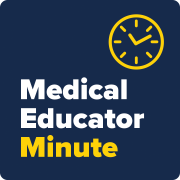Medical Educator Minute | Using a framework to design curriculum
As a faculty member or senior resident/fellow, you may be responsible for teaching a new topic to trainees or colleagues. Those new to medical education often begin by developing a lecture or learning exercise on the topic. However, research in medical education demonstrates that there is much more to teaching and learning than content. Using a framework for curriculum design can ensure you are using best practices when developing new teaching materials. There are many frameworks in the literature for curriculum design, including Kern’s Six Steps to Curriculum Development, the 4-D’s Framework, Universal Design for Learning (UDL), and curriculum mapping among others. Each of these frameworks have the following concepts in common:
- Establishing an explicit and clear learning purpose – this is not just about writing the learning objectives, but understanding the goal, what should your learners know or do?
- Needs Assessment – understanding your learners, what do they already know or do, and understanding the scope of the gap between the ideal and current state.
- Designing curriculum by selecting an educational strategy that aligns with the gap – what prevents your learners from reaching the ideal state? Is it a knowledge gap? Skills gap? Confidence gap? Design a curriculum that aligns with the specific needs of your learners.
- Implementation – thinking about available resources, barriers, and culture in your setting, implement the curriculum in a way that is feasible for your learning environment.
- Evaluation – it’s important to measure outcome goals that align with your learning purpose, whether that is an increase in knowledge or skills, or a change in practice behavior.
Using an established framework to guide the development of your educational sessions helps ensure your efforts accomplish your intended outcomes. For more specific information and guidance, check out these resources:
- Curriculum Development for Graduate Medical Educators
- Kern’s Six-step Approach to Curriculum Development for Medical Education
- The Four-Dimensional Curriculum Framework (4DF) for Health Professions Education



